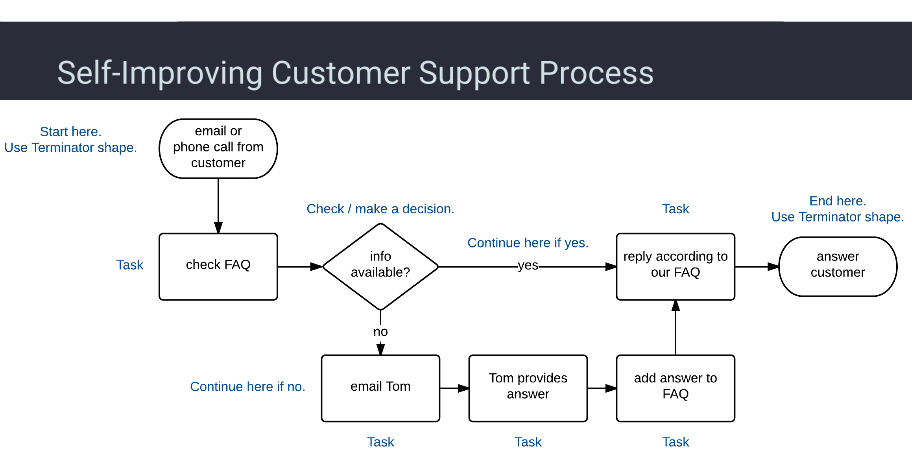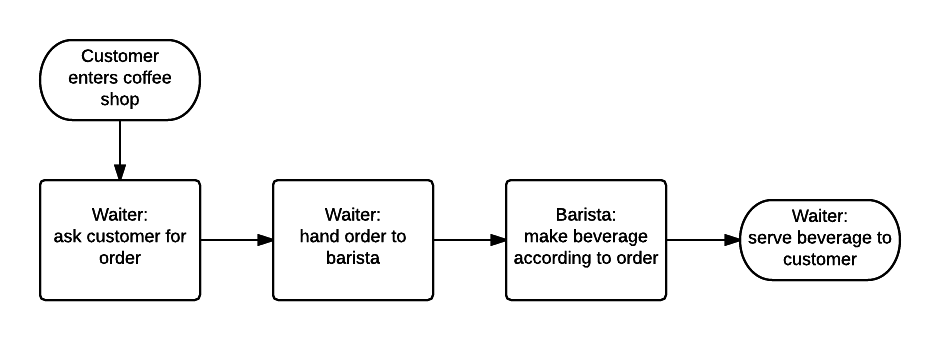Business Process Automation Guide
It’s time to get rid of busy work and putting out fires. Time to do some tasks for the last time. Time to delegate. Time to build reliable processes and systematize the operations of your business.
This guide will provide the principles, tools, and templates to get you started today.
You – at the Center of All Action
Many companies are based on and built around the core skill set of one person: the business owner. Even though your focus may have shifted towards marketing and sales or managing your team, it’s still you who knows most/best about your company’s product or service.
You therefore have to
- provide direction,
- make the decisions, and
- get things done.
This makes you valuable, in fact, indispensable. But, while this makes you feel great for a while, it also keeps you locked in and very, very busy.
The Value of Processes for Business
[…] most people’s “Quantum Leaps” in business are […] not just marketing breakthroughs but breakthroughs in delegation. — Perry Marshall
It’s hard to delegate if you don’t have processes in place.
So this guide is all about enabling you to improve and document your business processs. By translating your knowledge and skills into repeatable and reliable processes you’re essentially removing yourself from the operational part of your business — step by step.
Delegation Through Process and System
There is no delegation without documented processes.
It’s irrational to expect other people to do what you want them to do, in the way you want them to do it, without having a well-documented process for the task. Listen:
Only process will set you free.
Test this and see for yourself.
Transfer & Delegate
The definition of “delegate”: To intrust to the care or management of another; to transfer; to assign; to commit.
That is exactly what we’re doing: Transferring the business owner’s knowledge and skills into a process; then, assign that process to another person within the organization to handle it - with consistent results.
A Documented Process Example
Read some current examples from our case study with Storemapper.
Your Role as the Business Owner
What is your role and responsibility in this context? Where is your highest leverage?
- Build processes to delegate.
- Tweak and optimize.
- Orchestrate the system.
The Process Recipe
We are not inventing (new) processes. You already have processes. You may not know it yet, but we will get to that in a minute. What we will do is:
- Make implicit processes explicit.
- Streamline these processes.
- Put the processes back into the system.
10 Steps to Work Yourself Out of Busy Work
Now, let’s break that down a bit more.
- Identify the (implicit) processes and workflows in your business (ask “What happens when/if X? What happens after that? What needs to be decided? By whom? etc.”)
- Notice inputs and outputs of your processes, as well as the decision points.
- Map out each process visually 1 . Tip: Here’s a short video about the basics of process mapping.
- What will become obvious at this point is how complex or simple a given process actually is, and, where you might be able to simplify or streamline the process.
- Look for dead or loose ends at this point. Fix them.
- Redesign, improve, streamline and simplify each process or work flow.
- Document each process or workflow in detail.
- Make sure to check in with the people involved to see if they still have to deal with excessively time-consuming or stressful parts (in the process) and evaluate if/how you can further improve.
- Rinse and repeat.
- Go on holiday. (Seriously, test that your process is working as planned.)
Note: Read our case studies to see examples where we are applying exactly what is laid out here.
From Process to System
Once you repeatedly put the processes back into the system, you are beginning to build – and later maintain – a system.
While a process is a task, or series of tasks, which has been streamlined for efficiency and documented, the system is built of individual subsystems and their processes.
A process produces results through work being done in the process whereas a system produces results through the interaction of processes. - David Hoyle
Let’s consider processes the building blocks and the system the way these processes are organized and interact 2 .
We will start with the smaller unit, the process. One by one we will document each process which enables us to delegate. We will then move on to see and modify the dependencies and interactions of individual processes — shifting to optimizing the system.
Where to Start – Identifying Processes and Workflows
Frequency: For a good start, we are looking for anything that is repeating/recurring (or ongoing).
Complexity: To keep complexity low, the process we want to work on should involve 1 - 3 people in your team (as a rule of thumb).
Scope: The scope of a process, or you could say the level of zoom, is also important to consider. We want to strike a balance and find something that we can illustrate in a process map (see below) and still be able to grasp without the need to study it for hours.
As an example, this is the process map from the process mapping basics video.

The underlying scenario could be this: You have a service business and you hire someone to do customer support, answering the phone or reply to emails.
When you decided to bring someone in, you started to prepare this and composed a collection of all the questions people have about your service. At that point you wrote up everything that came to mind, but the problem is, people come up with new questions, not only variations, every day. So you came up with this ingenious plan. You built out this process where new questions get answered and added to your knowledge base (FAQ). This way you have to answer questions and solve problems only once.
How to Document Your Business Processes
Quick recap:
We are working on our business processes in order (to be
able) to delegate work. After we identified an implicit process and
made it explicit by drawing a flowchart or writing up a list of the steps
and decisions it involves, we have the opportunity to streamline
and optimize it.
For an easy start, we will look at some examples and templates to use here. But before we get to that, let’s address a question that will inevitbaly come up in this context.
What’s the Difference Between a Workflow, a Process and a Procedure?
A workflow is usually a visual representation of how information and work moves through your organization. A process can be represented as a workflow. That is why we can use the terms flowchart and process map interchangably. A procedure is a set of specific instructions necessary to perform a task or a part of our process.
Here’s an example:
At a coffee shop, the workflow to serve a customer may look like this.

The process is:
- (trigger) customer enters coffee shop
- the waiter asks the customer for their order
- the waiter hands the order to barista
- the barista prepares the beverage according to the order
- the waiter serves the beverage to the customer
- (end process)
One of possibly multiple procedures that are part of this workflow is to actually prepare the beverage that was ordered. There’s a specific procedure for each kind of beverage, and each procedure is detailed and specific.
Process Documentation as Living Documents
While the workflow level might be more stable, the procedures often change, or rather will be adjusted and improved. In a business, the procedures have to be continuously adjusted and improved because in many cases they exist in a dynamic environment. For example, the software that is being used will get updated and their user interface change. The person who is doing the procedure should therefore be able to update and adjust it when necessary.
Your business process documentation therefore is as a set of living documents. Updating these documents continually is what ensures that the system keeps on working.
Create Flowcharts / Process Maps
When you start documenting a process, it’s best to draft a list-style document or sketch out a flowchart / process map. The latter is more visual and gives you an overview of the elements and steps involved.
Here’s a 2-minute video that explains the basics for creating flowcharts.
Create Written Documentation
Written documentation of your buiness’ processes is key to being able to delegate work. I will give you some guidelines and templates, but no matter how you do it specifically, the goal is simple: write it down in a way that any person of reasonable intelligence can follow the instructions and get the task done.
Clear written instructions are the best way to scale yourself.
Here are some resources to use when documenting your own processes:
- SOP Template
- SOP Example - Creating a new SOP
- Documenting Processes PDF - click link to download as PDF file
Tools to Use
You need a place where you store your documentation. There are numerous options for that. Google Docs is very handy, especially if you and your team are already using it.
A different approach is setting up and using an internal wiki.
Make sure to use and include images/screenshots and/or videos/screencasts in your documentation.
Then, as you could already see here in this guide, flowcharts or process maps are a great way to visually capture your workflows. We use Google Drawings because it seamlessly integrates with Google Docs and allows for the same kind of collaboration.